

Mount Horeb. Moses with tablets of the Ten Commandments, painting by Rembrandt, (1659) Mount Horeb, Hebrew: חֹרֵב, Greek in the Septuagint: χωρηβ, Latin in the Vulgate: Horeb, is the mountain at which the book of Deuteronomy in the Hebrew Bible states that the Ten Commandments were given to Moses by God.
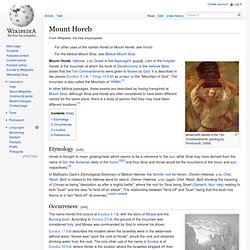
It is described in two places (Exodus 3:1, 1 Kings 19:8) as הַר הָאֱלֹהִים the "Mountain of God". The mountain is also called the Mountain of YHWH.[1] In other biblical passages, these events are described as having transpired at Mount Sinai. Although Sinai and Horeb are often considered to have been different names for the same place, there is a body of opinion that they may have been different locations.[1] Biblical Mount Sinai. The approach to Mount Sinai, painting by David Roberts.

Dindsenchas. Dindsenchas or Dindshenchas (modern spellings: Dinnseanchas or Dinnsheanchas), meaning "lore of places"[1] (the modern Irish word dinnseanchas means "topography")[2] is a class of onomastic text in early Irish literature, recounting the origins of place-names and traditions concerning events and characters associated with the places in question.
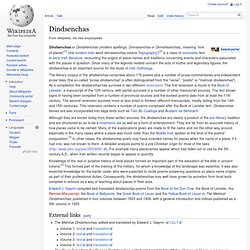
Since many of the legends related concern the acts of mythic and legendary figures, the dindsenchas is an important source for the study of Irish mythology. The literary corpus of the dindsenchas comprises about 176 poems plus a number of prose commentaries and independent prose tales (the so-called "prose dindsenchas" is often distinguished from the "verse", "poetic" or "metrical dindsenchas"). As a compilation the dindsenchas has survived in two different recensions. Mount Athos. Mount Athos (/ˈæθɒs/; Greek: Όρος Άθως, Óros Áthos [ˈoros ˈaθos]) is a mountain and peninsula in Greece.
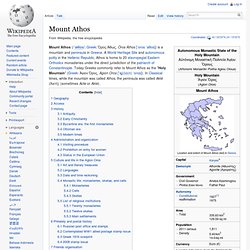
A World Heritage Site and autonomous polity in the Hellenic Republic, Athos is home to 20 stavropegial Eastern Orthodox monasteries under the direct jurisdiction of the patriarch of Constantinople. Today Greeks commonly refer to Mount Athos as the "Holy Mountain" (Greek: Άγιον Όρος, Agion Oros [ˈaʝ(i)o(n) ˈoros]). In Classical times, while the mountain was called Athos, the peninsula was called Akté (Ἀκτὴ) (sometimes Acte or Akte). Geography[edit] Map of Mount Athos The peninsula, the easternmost "leg" of the larger Chalkidiki peninsula, protrudes 50 kilometres (31 mi)[3] into the Aegean Sea at a width of between 7 and 12 kilometres (4.3 and 7.5 mi) and covers an area of 335.6 square kilometres (129.58 sq mi).
Access[edit] The number of daily visitors to Mount Athos is restricted, and all are required to obtain a special entrance permit valid for a limited period. Big Manitou Falls. Big Manitou Falls, the water's brown tint is caused by minerals.
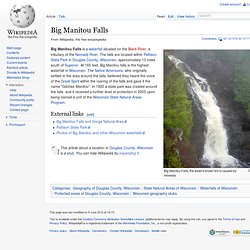
Manitou. Manitou are the spirit beings of Algonquian groups of Native Americans.

This spirit is seen as a contactable person as well as an idea. Everything has its own manitou—every plant, every stone, even machines. [citation needed] Aashaa Monetoo = good spirit, Otshee Monetoo= Bad Spirit. Sacred waters. Ubiquitous and perpetual fixations with water occur across religious traditions.
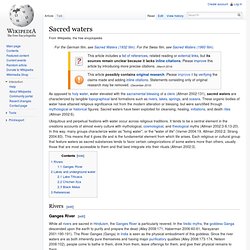
It tends to be a central element in the creations accounts of almost every culture with mythological, cosmological, and theological myths (Altman 2002:3-6,13-20). In this way, many groups characterize water as "living water", or the "water of life" (Varner 2004:19, Altman 2002:2, Strang 2004:83). This means that it gives life and is the fundamental element from which life arises. Each religious or cultural group that feature waters as sacred substances tends to favor certain categorizations of some waters more than others, usually those that are most accessible to them and that best integrate into their rituals (Altman 2002:3).
Aeaea. Aeaea or Eëa (/iːˈiːə/ ee-EE-ə or /əˈiːə/ ə-EE-ə; Ancient Greek: Αἰαία, Aiaía [aɪ.áɪ.a]) was a mythological island said to be the home of the sorceress Circe.
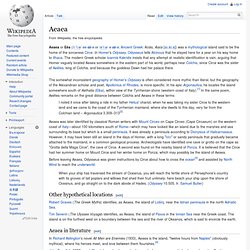
In Homer's Odyssey, Odysseus tells Alcinous that he stayed here for a year on his way home to Ithaca. The modern Greek scholar Ioannis Kakridis insists that any attempt at realistic identification is vain, arguing that Homer vaguely located Aeaea somewhere in the eastern part of his world, perhaps near Colchis, since Circe was the sister of Aeëtes, king of Colchis, and because the goddess Dawn had her palace there The somewhat inconsistent geography of Homer's Odyssey is often considered more mythic than literal, but the geography of the Alexandrian scholar and poet, Apollonius of Rhodes, is more specific. Before leaving Aeaea, Odysseus was given instructions by Circe about how to cross the ocean[3] and assisted by North Wind to reach the underworld: Other hypothetical locations[edit] Χώρα. Ancient Greek[edit] Alternative forms[edit] χώρη (khōrē) (Ionic) Etymology[edit] Uncertain.

Τόπος. Ancient Greek[edit] Pronunciation[edit] (5th BC Attic): IPA: /tópos/(1st BC Egyptian): IPA: /tópos/(4th AD Koine): IPA: /tópos/(10th AD Byzantine): IPA: /tópos/(15th AD Constantinopolitan): IPA: /tópos/
